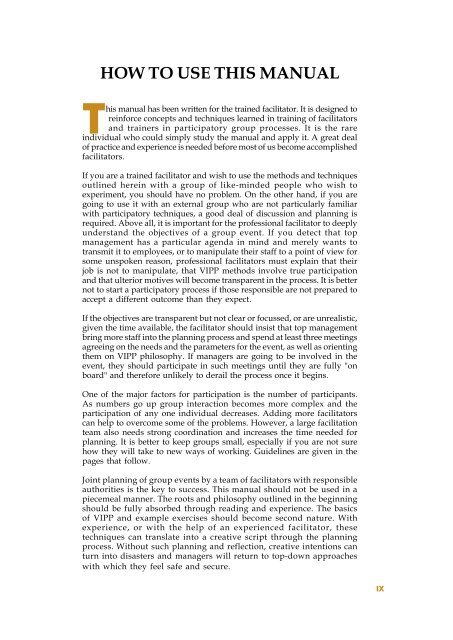VIPP_Unicef
VIPP_Unicef
VIPP_Unicef
Create successful ePaper yourself
Turn your PDF publications into a flip-book with our unique Google optimized e-Paper software.
HOW TO USE THIS MANUAL<br />
This manual has been written for the trained facilitator. It is designed to<br />
reinforce concepts and techniques learned in training of facilitators<br />
and trainers in participatory group processes. It is the rare<br />
individual who could simply study the manual and apply it. A great deal<br />
of practice and experience is needed before most of us become accomplished<br />
facilitators.<br />
If you are a trained facilitator and wish to use the methods and techniques<br />
outlined herein with a group of like-minded people who wish to<br />
experiment, you should have no problem. On the other hand, if you are<br />
going to use it with an external group who are not particularly familiar<br />
with participatory techniques, a good deal of discussion and planning is<br />
required. Above all, it is important for the professional facilitator to deeply<br />
understand the objectives of a group event. If you detect that top<br />
management has a particular agenda in mind and merely wants to<br />
transmit it to employees, or to manipulate their staff to a point of view for<br />
some unspoken reason, professional facilitators must explain that their<br />
job is not to manipulate, that <strong>VIPP</strong> methods involve true participation<br />
and that ulterior motives will become transparent in the process. It is better<br />
not to start a participatory process if those responsible are not prepared to<br />
accept a different outcome than they expect.<br />
If the objectives are transparent but not clear or focussed, or are unrealistic,<br />
given the time available, the facilitator should insist that top management<br />
bring more staff into the planning process and spend at least three meetings<br />
agreeing on the needs and the parameters for the event, as well as orienting<br />
them on <strong>VIPP</strong> philosophy. If managers are going to be involved in the<br />
event, they should participate in such meetings until they are fully "on<br />
board" and therefore unlikely to derail the process once it begins.<br />
One of the major factors for participation is the number of participants.<br />
As numbers go up group interaction becomes more complex and the<br />
participation of any one individual decreases. Adding more facilitators<br />
can help to overcome some of the problems. However, a large facilitation<br />
team also needs strong coordination and increases the time needed for<br />
planning. It is better to keep groups small, especially if you are not sure<br />
how they will take to new ways of working. Guidelines are given in the<br />
pages that follow.<br />
Joint planning of group events by a team of facilitators with responsible<br />
authorities is the key to success. This manual should not be used in a<br />
piecemeal manner. The roots and philosophy outlined in the beginning<br />
should be fully absorbed through reading and experience. The basics<br />
of <strong>VIPP</strong> and example exercises should become second nature. With<br />
experience, or with the help of an experienced facilitator, these<br />
techniques can translate into a creative script through the planning<br />
process. Without such planning and reflection, creative intentions can<br />
turn into disasters and managers will return to top-down approaches<br />
with which they feel safe and secure.<br />
IX


